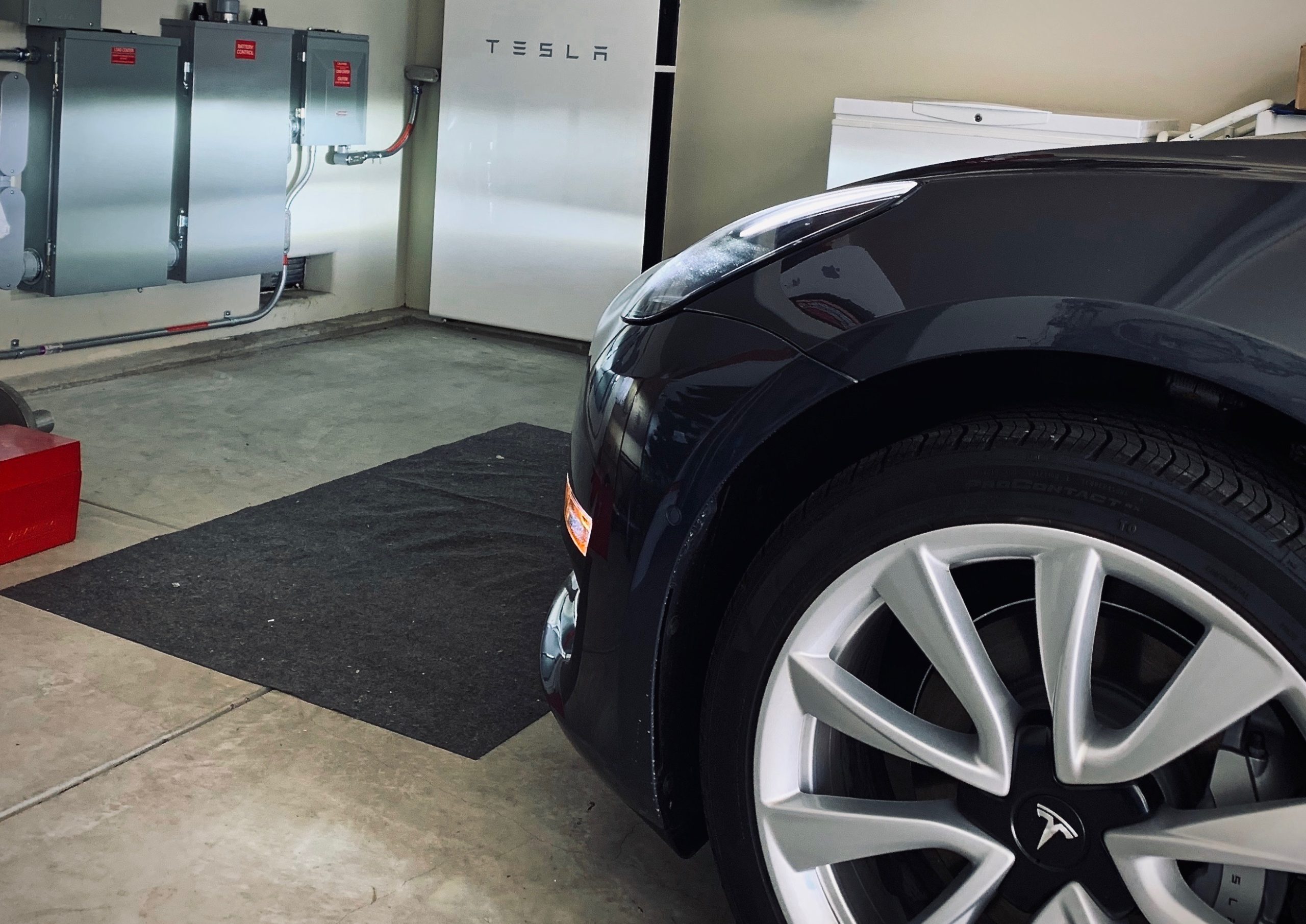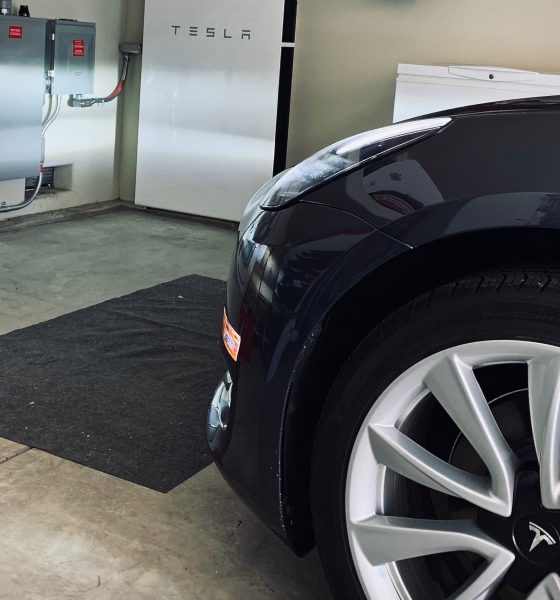

News
Tesla Powerwall smarter integration with vehicle charging hinted at in API code
Recent observations from Tesla’s Powerwall API hint that the company’s electric cars will soon have a feature that will allow them to communicate better with the home battery system. With such a system in place, Tesla’s electric cars will not drain the Powerwall when the grid goes down.
The upcoming Powerwall and Tesla integration feature was first spotted by Model X owner and Reddit user u/cwiedmann.
“Looking through the data returned from the API, I see there’s now evidence of upcoming features for integrating Powerwalls and car charging as Elon mentioned. This appears to be support for preventing car charging from draining the batteries when the grid is down and maybe to allow the car to absorb surplus solar energy,” u/cwiedmann wrote on the r/TeslaMotors subreddit.
When the grid goes down, Tesla Powerwalls can meet the energy demands of a home, including charging an electric car like the Model 3, Model X, or Model S. That being said, there’s a big room for improvement especially when it comes to how a Tesla vehicle communicates with the home battery system. Tesla’s electric cars have massive battery packs after all, and they can drain an off-grid Powerwall if left unattended.
This appears to have happened in May 2019 to Tesla owner Erik Strait, who also runs the YouTube channel DӔrik. Strait brought up the Powerwall issue they encountered in Colorado and suggested features that may come handy to consumers, such as a setting that allows the home battery system to prevent cars charging when they are off the grid. Tesla CEO Elon Musk responded with a brief “Coming soon.”
Coming soon
— Elon Musk (@elonmusk) May 22, 2019
Elon Musk posted his response to the Tesla owner-enthusiast last May, and there have been few updates on the feature since. Nevertheless, references to the feature in the Powerwall’s API today suggests that the home battery-electric vehicle integration may be coming sooner than expected. How the functionality will be rolled out remains to be seen too, but there’s a good chance that Tesla may introduce the feature through an over-the-air update, similar to how the company activates “Storm Watch” for Powerwall-equipped homes located in areas that are facing natural disasters.
Ultimately, the upcoming Powerwall feature shows that Tesla is making a lot of headway in integrating key features of its energy products and its electric cars. This ecosystem could ultimately encourage buyers of Tesla’s electric cars to adopt the company’s energy and battery storage products too, similar to how Apple has encouraged customers to purchase devices within its product line due to their feature integration.
Very early on, we had the ability to use the car as a battery outputting power. Maybe worth revisiting that.
— Elon Musk (@elonmusk) July 4, 2018
These recent observations on the Powerwall API also invoke some thoughts on a feature that was mentioned by Elon Musk back in 2018. In a tweet then, Musk noted that it may be worth revisiting the idea of using its cars as batteries that output power, similar to a V2G (vehicle-to-grid) system. Tesla does seem to be exploring this idea recently, as hinted at by the Cybertruck’s capability to use its massive battery pack to power tools from its onboard outlets.
Teslarati will update you once the Powerwall-Tesla electric vehicle integration feature goes live. For now, this is a welcome development so the habit of “always be charging” does not lead one to a home without power. But of course, there’s always Camp Mode just in case.
Upcoming Powerwall/Vehicle Integration API Leaks from r/teslamotors

News
Tesla FSD v14.2.2 is getting rave reviews from drivers
So far, early testers have reported buttery-smooth drives with confident performance, even at night or on twisty roads.

Tesla Full Self-Driving (Supervised) v14.2.2 is receiving positive reviews from owners, with several drivers praising the build’s lack of hesitation during lane changes and its smoother decision-making, among others.
The update, which started rolling out on Monday, also adds features like dynamic arrival pin adjustment. So far, early testers have reported buttery-smooth drives with confident performance, even at night or on twisty roads.
Owners highlight major improvements
Longtime Tesla owner and FSD user @BLKMDL3 shared a detailed 10-hour impression of FSD v14.2.2, noting that the system exhibited “zero lane change hesitation” and “extremely refined” lane choices. He praised Mad Max mode’s performance, stellar parking in locations including ticket dispensers, and impressive canyon runs even in dark conditions.
Fellow FSD user Dan Burkland reported an hour of FSD v14.2.2’s nighttime driving with “zero hesitations” and “buttery smooth” confidence reminiscent of Robotaxi rides in areas such as Austin, Texas. Veteran FSD user Whole Mars Catalog also demonstrated voice navigation via Grok, while Tesla owner Devin Olsen completed a nearly two-hour drive with FSD v14.2.2 in heavy traffic and rain with strong performance.
Closer to unsupervised
FSD has been receiving rave reviews, even from Tesla’s competitors. Xpeng CEO He Xiaopeng, for one, offered fresh praise for FSD v14.2 after visiting Silicon Valley. Following extended test drives of Tesla vehicles running the latest FSD software, He stated that the system has made major strides, reinforcing his view that Tesla’s approach to autonomy is indeed the proper path towards autonomy.
According to He, Tesla’s FSD has evolved from a smooth Level 2 advanced driver assistance system into what he described as a “near-Level 4” experience in terms of capabilities. While acknowledging that areas of improvement are still present, the Xpeng CEO stated that FSD’s current iteration significantly surpasses last year’s capabilities. He also reiterated his belief that Tesla’s strategy of using the same autonomous software and hardware architecture across private vehicles and robotaxis is the right long-term approach, as it would allow users to bypass intermediate autonomy stages and move closer to Level 4 functionality.
News
Elon Musk’s Grok AI to be used in U.S. War Department’s bespoke AI platform
The partnership aims to provide advanced capabilities to 3 million military and civilian personnel.

The U.S. Department of War announced Monday an agreement with Elon Musk’s xAI to embed the company’s frontier artificial intelligence systems, powered by the Grok family of models, into the department’s bespoke AI platform GenAI.mil.
The partnership aims to provide advanced capabilities to 3 million military and civilian personnel, with initial deployment targeted for early 2026 at Impact Level 5 (IL5) for secure handling of Controlled Unclassified Information.
xAI Integration
As noted by the War Department’s press release, GenAI.mil, its bespoke AI platform, will gain xAI for the Government’s suite of tools, which enable real-time global insights from the X platform for “decisive information advantage.” The rollout builds on xAI’s July launch of products for U.S. government customers, including federal, state, local, and national security use cases.
“Targeted for initial deployment in early 2026, this integration will allow all military and civilian personnel to use xAI’s capabilities at Impact Level 5 (IL5), enabling the secure handling of Controlled Unclassified Information (CUI) in daily workflows. Users will also gain access to real‑time global insights from the X platform, providing War Department personnel with a decisive information advantage,” the Department of War wrote in a press release.
Strategic advantages
The deal marks another step in the Department of War’s efforts to use cutting-edge AI in its operations. xAI, for its part, highlighted that its tools can support administrative tasks at the federal, state and local levels, as well as “critical mission use cases” at the front line of military operations.
“The War Department will continue scaling an AI ecosystem built for speed, security, and decision superiority. Newly IL5-certified capabilities will empower every aspect of the Department’s workforce, turning AI into a daily operational asset. This announcement marks another milestone in America’s AI revolution, and the War Department is driving that momentum forward,” the War Department noted.
News
Tesla FSD (Supervised) v14.2.2 starts rolling out
The update focuses on smoother real-world performance, better obstacle awareness, and precise end-of-trip routing, among other improvements.

Tesla has started rolling out Full Self-Driving (Supervised) v14.2.2, bringing further refinements to its most advanced driver-assist system. The new FSD update focuses on smoother real-world performance, better obstacle awareness, and precise end-of-trip routing, among other improvements.
Key FSD v14.2.2 improvements
As noted by Not a Tesla App, FSD v14.2.2 upgrades the vision encoder neural network with higher resolution features, enhancing detection of emergency vehicles, road obstacles, and human gestures. New Arrival Options let users select preferred drop-off styles, such as Parking Lot, Street, Driveway, Parking Garage, or Curbside, with the navigation pin automatically adjusting to the user’s ideal spot for precision.
Other additions include pulling over for emergency vehicles, real-time vision-based detours for blocked roads, improved gate and debris handling, and extreme Speed Profiles for customized driving styles. Reliability gains cover fault recovery, residue alerts on the windshield, and automatic narrow-field camera washing for new 2026 Model Y units.
FSD v14.2.2 also boosts unprotected turns, lane changes, cut-ins, and school bus scenarios, among other things. Tesla also noted that users’ FSD statistics will be saved under Controls > Autopilot, which should help drivers easily view how much they are using FSD in their daily drives.
Key FSD v14.2.2 release notes
Full Self-Driving (Supervised) v14.2.2 includes:
- Upgraded the neural network vision encoder, leveraging higher resolution features to further improve scenarios like handling emergency vehicles, obstacles on the road, and human gestures.
- Added Arrival Options for you to select where FSD should park: in a Parking Lot, on the Street, in a Driveway, in a Parking Garage, or at the Curbside.
- Added handling to pull over or yield for emergency vehicles (e.g. police cars, fire trucks, ambulances).
- Added navigation and routing into the vision-based neural network for real-time handling of blocked roads and detours.
- Added additional Speed Profile to further customize driving style preference.
- Improved handling for static and dynamic gates.
- Improved offsetting for road debris (e.g. tires, tree branches, boxes).
- Improve handling of several scenarios, including unprotected turns, lane changes, vehicle cut-ins, and school buses.
- Improved FSD’s ability to manage system faults and recover smoothly from degraded operation for enhanced reliability.
- Added alerting for residue build-up on interior windshield that may impact front camera visibility. If affected, visit Service for cleaning!
- Added automatic narrow field washing to provide rapid and efficient front camera self-cleaning, and optimize aerodynamics wash at higher vehicle speed.
- Camera visibility can lead to increased attention monitoring sensitivity.
Upcoming Improvements:
- Overall smoothness and sentience.
- Parking spot selection and parking quality.








